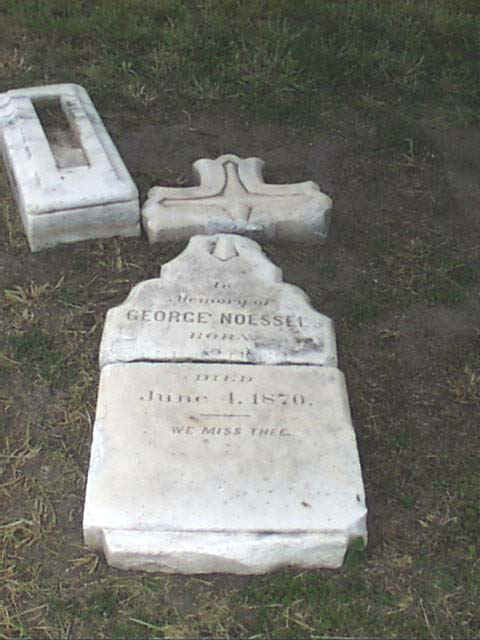George Noessel
In
memory of
George Noessel
Died
June 4, 1870
We Miss Thee

Photo Credit: Rosa G. Gonzales
1. Photograph of George Noessel
Provenance: Corpus Christi Public Libraries
2. Biography
He was born in Hesse Cassel, Germany, 1813. He came to this country in 1831, landing in Baltimore, Maryland. In 1834 he was (shipping) cargo from New Orleans to Cuidad Camargo, Mexico via Aransas Pass, Texas. While chasing ponies, he was captured by the Indians. Escaping, he reached Camargo in safety; then fled further to Matamoras, Mexico. He was employed by the Beldon (blank). Her returned to New Orleans and opened a cigar store on the corner of Canal Street and Charles Street where he massed a small fortune. He married in 1839. He returned to Texas and established himself in Bastrop. He took part in The Archives War of Texas in 1839. He is mentioned in the history of Yoakum, Texas (Vol. II, p 355) after losing all, he returned to New Orleans, opened a daguerreotype Gallery.
When the Mexican War broke out, he organized a company of volunteers called Mountaineers in 1846. He accompanied the United States troops to Vera Cruz, Mexico, talking charge of citizens’ trains to Mexico City and the interior. A train was captured and defeated. In 1847-----again in New Orleans--- he met Col. H. L. Kinney of Corpus Christi, Texas. He was assisted by Felix Noessel, his son; and continued operations under the name of Noessel and Son. He died June 4, 1870, in Corpus Christi, Texas His wife survived at 87 years; also surviving were two sons and one daughter. Her son, Felix, served as an officer, First Lieutenant in Hobbs Regiment, Confederate States of America.
Source: Corpus Christi Museum of Science and History Collections
Files of: Mr. John Lege, San Antonio, TX, descendant
Transcription: Geraldine D. McGloin, Nueces County Historical Commission
3. Reference from The Daguerrerian Annual, 1993
George Noessel was born in Hesse-Kasel (Germany) around 1813. He and his wife, Thekla, were living in Louisiana in 1838 at the time of the birth of their child Otto. Noessel moved to the Republic of Texas by 1840; in June 10 of that year he received a conditional grant to 640 acres in Bastrop County. Sometime between 1842 and 1845 the Noessels moved to New Orleans. In that city from 1845 to 1847, George owned successive daguerreian galleries at the corner of St. Charles and Union Streets, 18 Royal Street, and at the corner of Poydras and Camp Streets. In November 1846 in New Orleans, Noessel took the daguerreotype portraits of two famous Texas Ranger officers, Samuel Walker and John Coffee Hays. The following year, an engraving based on Noessel's portrait of Hays appeared in Samuel Chester Reid's book, Scouting Expeditions of McCulloch's Texas Rangers (Philadelphia: G. B. Zieber & Co., 1847).
In the early summer of 1847, during the Mexican War, Noessel sailed to Veracruz, Mexico; through the remainder of that year he operated daguerreian galleries with some success at several locations there. On January 1, 1848, the New Orleans Picayune reported that Noessel was "picking up interesting subjects with whose portraits to enrich his [Veracruz] gallery." In particular, Noessel had daguerreotyped Col. Manuel Dominguez, the commander of a "spy company" of renegade Mexicans in the service of the U.S. Army. Of Noessel's daguerreotype of Dominguez, the reporter noted that "The colonel is no beauty, our readers may be assured. Coarse sensuality is the predominant characteristic of the face."
In early January 1848, Noessel closed his daguerreotype gallery and took command of a merchants' wagon train bound from Veracruz to Mexico City. As principal conductor of the train, Noessel was responsible for 900 pack mules and 60 wagons carrying over a million dollars in merchandise. Although bandits drove off three hundred pack mules on the second day of the journey, Noessel brought the remainder of the train safely to Mexico City. The merchants of that city elected Noessel to conduct a train from there back to Veracruz in February 1848.
After the Mexican War, Noessel settled in Corpus Christi. He bought the famed Kinney House in that city around 1849. It is likely that Noessel continued to practice the daguerreotype process after moving to Corpus Christi. For example, in September 1852 Humphrey's Journal, a photographic magazine, published an editorial communication to "G. W. N., Texas," with advice on common salt versus hyposulphite of soda as fixing agents for paper photographs. Since there are no other photographers matching those first and last initials documented in Texas in the 1850s, "G.W.N." may have been George Noessel.
Source: Kailbourn, Thomas R. "S.D. Allis, Vera Cruz, 1847." In The Daguerrerian Annual, 1993. Edited by Peter E. Palmquist. Green Bay, Wisconsin: Daguerreian Society, 1993, p. 84-90.
Information courtesy of Thomas R. Kailbourn
Transcription by: Geraldine D. McGloin, Nueces County Historical Commission
4. Obituary
DIED
Passengers by the steamer S. J. Lee, report the death of Mr. Geo. Noessel, who died at Corpus Christi, last week. Mr. Noessel was well and favorably known along this border, and was considered as a most estimable citizen in the place where he lived and elsewhere.
Source: Daily Ranchero of Brownsville, Tuesday, June 14, 1870, p.2 col 2
Research by: Msgr. Michael A. Howell
Transcription: Geraldine D. McGloin, Nueces County Historical Commission